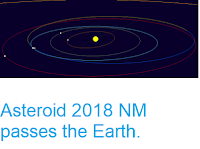Asteroid 2003 KT24 passed by the Earth at a distance of about 12 732 000
km (33.1 times the average distance between the Earth and the Moon, or 8.51% of the distance between the Earth and the Sun), slightly after 7.30 pm
GMT on Saturday 21 July 2018. There was no danger of
the asteroid hitting us, though were it to do so it would have
presented a significant threat. 2003 KT24 has an estimated
equivalent
diameter of 260-820 m (i.e. it is estimated that a spherical object
with
the same volume would be 260-820 m in diameter), and an object of this size would be predicted to be capable of
passing through the Earth's
atmosphere relatively intact, impacting the ground directly with an
explosion that would be 35 000-1 750 000 times as powerful as the
Hiroshima
bomb. Such an impact would result in an impact crater 4-12 km
in
diameter
and devastation on a global scale, as well as climatic effects that
would last decades or even centuries.
Asteroid 2003 KT24 imaged from Japan on 20 July 2018. Image is a composite derived from 20 exposures, each of 30
seconds. Elongate structures are stars, asteroid is at centre of picture. The object it labelled as 2018 NB as it was re-discovered in July 2018 and initially thought to be a new asteroid, and therefore renamed. Bunmyo Mieto/Yahoo Japan.
2003 KT24 was discovered by the Cerro Tololo Inter-American Observatory in Chile on 31 May 2003. The designation 2003 KT24 indicates that the asteroid was the 619th asteroid (asteroid T24) discovered in the second half of May 2003 (period 2003 K). The asteroid was re-discovered by the Atlas MLO Telescope at Mauna Loa Observatory in Hawaii on 1 July 2018, and initially thought to be a new body, resulting in it being given the name 2018 NB, which indicates the second asteroid (asteroid B) discovered in the first half of July 2018 (period 2018 N).
The calculated orbit of asteroid 2003 KT24. Minor Planet Center.
2003 KT24 has a 1352 day orbital period and an eccentric orbit
tilted at an angle of 0.92° to the plane of the Solar System, which
takes it from 1.07 AU from the Sun (i.e. 107% of he average distance at
which the Earth orbits the Sun) to 3.72 AU from the Sun (i.e. 372% of
the
average distance at which the Earth orbits the Sun, and more than twice as far from the Sun as the planet Mars). It is therefore
classed as an Amor Group Asteroid (an asteroid which comes close to the
Earth, but which is never closer to the Sun than the Earth is). This means that the
asteroid has occasional close encounters with the Earth, with the last thought to have happened in September 1992 and the
next predicted
in September 2029.
2003 KT24 also
has occasional close encounters with the planets Mar, which it is
thought to have last passed in June 2011, and Jupiter, which it last came close
to in July 1990
and
is next predicted to pass in December 2028. Asteroids
which make close passes to multiple planets are considered to be in
unstable orbits, and are often eventually knocked out of these orbits by
these encounters, either being knocked onto a new, more stable orbit,
dropped into the Sun, knocked out of the Solar System or occasionally
colliding with a planet.
See also...
Follow Sciency Thoughts on Facebook.








